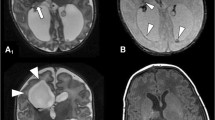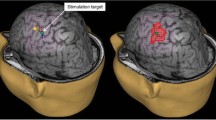Abstract
Malformations of cortical development such as polymicrogyria can cause medically refractory epilepsy. Epilepsy surgery (hemispherotomy) can be a good treatment option. In recent years, navigated transcranial magnetic stimulation (nTMS), a noninvasive brain mapping technique, has been used to localize the eloquent cortex for presurgical evaluation of patients with epilepsy. In the present case study, neurophysiological markers of the primary motor cortex (M1), including resting motor threshold (rMT), motor evoked potentials (MEPs), and silent period (SP), were assessed in both hands of a right-handed 10-year-old girl with a history of epilepsy and right hemispheric polymicrogyria. Bilateral MEPs with short latencies were elicited from the contralesional side. The average MEP amplitude and the latency for the patient’s paretic and non-paretic hands differed significantly. We conclude that nTMS is a safe and tolerable procedure that can be used for presurgical evaluation in children with intractable epilepsy.


Similar content being viewed by others
Availability of data and material
Not applicable.
Abbreviations
- nTMS:
-
Navigated transcranial magnetic stimulation
- M1:
-
Primary motor cortex
- rMT:
-
Resting motor threshold
- MEP:
-
Motor evoked potential
- SP:
-
Silent period
- DCS:
-
Direct cortical stimulation
- EMG:
-
Electromyography
- APB:
-
Abductor pollicis brevis
References
Zsoter A, Pieper T, Kudernatsch M, Staudt M (2012) Predicting hand function after hemispherotomy: TMS versus fMRI in hemispheric polymicrogyria. Epilepsia 53(6):e98–101. https://doi.org/10.1111/j.1528-1167.2012.03452.x. Pub 2012 Mar 29. PMID: 22462681
Foesleitner O, Nenning KH, Traub-Weidinger T, Feucht M, Bonelli S, Czech T, Dorfer C, Prayer D, Kasprian G (2018) Assessing corticospinal tract asymmetry in unilateral polymicrogyria. AJNR Am J Neuroradiol 39(8):1530–1535. https://doi.org/10.3174/ajnr.A5715. Epub 2018 Jun 28. PMID: 29954815; PMCID: PMC7410550
Yang CY, Chen HH, Chen C, Chiu JW, Chou CL, Yang TF (2017) Pattern of corticospinal projections defined by brain mapping during resective epilepsy surgery in a patient with congenital hemiparesis and intractable epilepsy. World Neurosurg 107:1050.e9-1050.e12. https://doi.org/10.1016/j.wneu.2017.08.071. Epub 2017 Aug 24 PMID: 28842233
Mäkelä JP, Vitikainen AM, Lioumis P, Paetau R, Ahtola E, Kuusela L, Valanne L, Blomstedt G, Gaily E (2013) Functional plasticity of the motor cortical structures demonstrated by navigated TMS in two patients with epilepsy. Brain Stimul 6(3):286–291. https://doi.org/10.1016/j.brs.2012.04.012. Epub 2012 May 23 PMID: 22659020
Jeltema HR, Ohlerth AK, de Wit A, Wagemakers M, Rofes A, Bastiaanse R, Drost G (2020) Comparing navigated transcranial magnetic stimulation mapping and “gold standard” direct cortical stimulation mapping in neurosurgery: a systematic review. Neurosurg Rev. https://doi.org/10.1007/s10143-020-01397-x. Epub ahead of print. PMID: 33009990
Thordstein M, Hallböök T, Lundgren J, van Westen D, Elam M (2011) Transfer of cortical motor representation after a perinatal cerebral insult. Pediatr Neurol 44(2):131–134. https://doi.org/10.1016/j.pediatrneurol.2010.08.017. PMID: 21215913
Narayana S, Papanicolaou AC, McGregor A, Boop FA, Wheless JW (2015) Clinical applications of transcranial magnetic stimulation in pediatric neurology. J Child Neurol 30(9):1111–1124. https://doi.org/10.1177/0883073814553274. Epub 2014 Oct 23 PMID: 25342309
Bashir S, Perez JM, Horvath JC, Pascual-Leone A (2013) Differentiation of motor cortical representation of hand muscles by navigated mapping of optimal TMS current directions in healthy subjects. J Clin Neurophysiol 30(4):390–395. https://doi.org/10.1097/WNP.0b013e31829dda6b. PMID: 23912579; PMCID: PMC3740163
Sollmann N, Wildschuetz N, Kelm A, Conway N, Moser T, Bulubas L, Kirschke JS, Meyer B, Krieg SM (2018) Associations between clinical outcome and navigated transcranial magnetic stimulation characteristics in patients with motor-eloquent brain lesions: a combined navigated transcranial magnetic stimulation-diffusion tensor imaging fiber tracking approach. J Neurosurg 128(3):800–810. https://doi.org/10.3171/2016.11.JNS162322. Epub 2017 Mar 31 PMID: 28362239
Roh CH, Kim DS, Kim GW, Won YH, Ko MH, Seo JH, Park SH (2022) Motor organization of unilateral polymicrogyria associated with ipsilateral brainstem atrophy - a case report. BMC Neurol 22(1):303. https://doi.org/10.1186/s12883-022-02795-y. PMID: 35982397; PMCID: PMC9386979
Hömberg V, Stephan KM, Netz J (1991) Transcranial stimulation of motor cortex in upper motor neurone syndrome: its relation to the motor deficit. Electroencephalogr Clin Neurophysiol 81(5):377–388. https://doi.org/10.1016/0168-5597(91)90027-u. PMID: 1718724
Nardone R, Sebastianelli L, Ferrazzoli D, Brigo F, Lochner P, Saltuari L, Trinka E, Versace V (2021) Brain functional reorganization in children with hemiplegic cerebral palsy: assessment with TMS and therapeutic perspectives. Neurophysiol Clin 51(5):391–408. https://doi.org/10.1016/j.neucli.2021.09.002. Epub 2021 Oct 4 PMID: 34615605
Firmin L, Müller S, Rösler KM (2012) The latency distribution of motor evoked potentials in patients with multiple sclerosis. Clin Neurophysiol 123(12):2414–2421. https://doi.org/10.1016/j.clinph.2012.05.008. Epub 2012 Jun 15 PMID: 22705226
Acknowledgements
We thank the patient and his family for cooperating with this study.
Funding
Not applicable.
Author information
Authors and Affiliations
Contributions
AM, RA and SB contributed to initial drafts of this publication; AM and SB revised later drafts. All authors reviewed and approved the final draft.
Corresponding author
Ethics declarations
Ethics approval and consent to participate
King Fahad Specialist Hospital Dammam committee on human research approved this study, and informed consent was obtained from the subject.
Consent for publication
Not applicable.
Conflict of interest
The authors declare no competing interests.
Additional information
Publisher's Note
Springer Nature remains neutral with regard to jurisdictional claims in published maps and institutional affiliations.
Rights and permissions
Springer Nature or its licensor (e.g. a society or other partner) holds exclusive rights to this article under a publishing agreement with the author(s) or other rightsholder(s); author self-archiving of the accepted manuscript version of this article is solely governed by the terms of such publishing agreement and applicable law.
About this article
Cite this article
Mir, A., AlBaradie, R. & Bashir, S. Navigated transcranial magnetic stimulation to measure motor evoked potentials in a child with hemispheric polymicrogyria and focal epilepsy. Childs Nerv Syst 40, 957–960 (2024). https://doi.org/10.1007/s00381-023-06196-5
Received:
Accepted:
Published:
Issue Date:
DOI: https://doi.org/10.1007/s00381-023-06196-5




